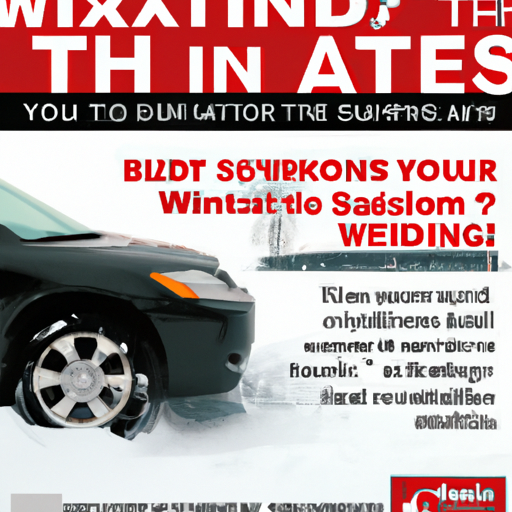In this article, you will learn about the key differences between winter tires and all-season tires. It is important to understand the distinctions between these two tire options, especially if you live in an area with harsh winters. By exploring the unique features of winter and all-season tires, you will be able to make an informed decision that ensures optimal performance and safety on the road. So, let’s explore the differences and see which type of tire is best suited for your needs.

Tread Design
Snow Tread Design
Winter tires are specifically designed to perform in cold weather conditions, including snow and ice. One of the key features of winter tires is their unique snow tread design. These tires are equipped with deep grooves and sipes to provide enhanced traction on slippery surfaces. The grooves help to channel snow, slush, and water away from the tire’s contact patch, allowing it to maintain a better grip on the road. The sipes, which are thin slits in the tread blocks, create additional biting edges that improve traction on icy and snowy surfaces. This specialized tread design allows winter tires to effectively navigate through challenging winter conditions and provide better control and stability.
Ribbed Tread Design
All-season tires, on the other hand, have a ribbed tread design. This design features larger tread blocks in the center of the tire, which provide stability and improved dry handling. The ribbed tread design allows for better responsiveness and enhanced performance in dry and wet conditions. However, when it comes to snowy and icy conditions, the ribbed tread may not provide the same level of traction as winter tires. The larger blocks can cause the tires to slide or lose grip on slippery surfaces. While all-season tires may have some limited snow traction, they are not optimized for severe winter weather conditions.
Symmetrical Tread Design
Symmetrical tread design is a common feature found in both winter and all-season tires. With this design, the tread pattern on each side of the tire is the same or mirror image of the other side. This design offers balanced performance and versatility in various weather conditions. The symmetrical tread design provides good traction on both dry and wet surfaces. However, compared to the specialized snow tread design of winter tires, the symmetrical tread may not provide the same level of grip and performance in severe winter conditions. It is important to note that not all all-season tires have symmetrical tread patterns, as some may have asymmetrical or directional tread designs for specific performance characteristics.
Rubber Compound
Winter Tire Rubber Compound
Winter tires are made with a specific rubber compound that remains flexible in cold temperatures. This unique rubber compound allows the tire to retain its grip on icy and snowy surfaces. The rubber used in winter tires contains a higher percentage of natural rubber and special additives, such as silica, to enhance traction and handling. The softer rubber compound provides better grip and traction, ensuring that the tire can conform to the road surface and maintain control even in freezing conditions. This winter-specific rubber compound is optimized to prevent hardening or stiffening in cold temperatures, allowing for safer and more predictable handling in winter weather.
All-Season Tire Rubber Compound
All-season tires are designed with a rubber compound that is formulated to provide a balance of traction and longevity in a wide range of weather conditions. The rubber used in all-season tires is generally harder and less flexible compared to winter tires. This harder rubber compound allows for better durability and longer tread life, making all-season tires a popular choice for drivers who want a tire that can perform reasonably well throughout the year. However, the trade-off is that the rubber compound of all-season tires may not provide the same level of grip and traction in cold temperatures as winter tires. All-season tires are more suitable for moderate climates where the temperatures rarely drop below freezing.
Temperature Range
Winter Tire Temperature Range
Winter tires are specifically designed to excel in colder temperatures. These tires are engineered to provide optimal performance when the mercury drops below 45°F (7°C). The specialized rubber compound of winter tires remains more flexible in these colder temperatures, allowing for better traction and grip on icy and snow-covered roads. When the temperature dips below this threshold, winter tires provide enhanced safety and control, ensuring that you can confidently navigate through winter conditions without compromising on performance.
All-Season Tire Temperature Range
All-season tires are designed to perform well across a wide range of temperatures, including both hot summers and cold winters. However, their optimum performance is typically seen in temperatures above 45°F (7°C) and when the roads are dry or wet. All-season tires may not provide the same level of grip and traction in extreme cold temperatures as winter tires. As the temperature drops, the rubber compound of all-season tires tends to get harder, resulting in reduced traction and compromised handling. Therefore, if you experience frequent snowfall or live in an area where freezing temperatures are common, opting for dedicated winter tires is highly recommended.
Traction
Winter Tire Traction
Winter tires are designed to provide superior traction on snow/ice-covered and cold roads. The tread design, coupled with the specialized rubber compound, allows winter tires to dig into the snow and keep a firm grip on icy surfaces. The deep grooves and sipes help to evacuate snow and water, ensuring that the tire maintains contact with the road surface. Winter tires are engineered to bite into the snow, providing excellent acceleration, braking, and cornering performance in winter conditions. The enhanced traction of winter tires significantly reduces the chances of slipping or getting stuck, making them an essential choice for winter driving.
All-Season Tire Traction
All-season tires are designed to offer reliable traction in a variety of driving conditions, including dry, wet, and mildly snowy conditions. However, when compared to winter tires, all-season tires may have limitations in severe snow and ice. The tread design and rubber compound of all-season tires are optimized for versatility and longevity, rather than extreme winter traction. All-season tires provide satisfactory traction on wet and dry roads, but their performance on icy or snowy surfaces is typically reduced. All-season tires are most effective in regions with mild winters or infrequent snowfall, where the roads are generally plowed and conditions are not severe.

Handling
Winter Tire Handling
Winter tires are designed to provide excellent handling characteristics in cold and icy conditions. The specialized rubber compound remains pliable, ensuring that the tire can conform to the road surface and maintain better control. The aggressive tread pattern of winter tires allows for improved grip and stability when cornering or maneuvering through snowy and icy roads. The sipes and grooves in the tread help to bite into the surface, enhancing overall handling performance. Winter tires offer better responsiveness and feedback, giving you increased confidence and control when driving in winter weather.
All-Season Tire Handling
All-season tires are designed to provide good handling in a variety of weather conditions, including dry, wet, and moderately snowy conditions. The ribbed tread design of all-season tires offers stability and improved handling on dry roads. These tires provide predictable and responsive handling during everyday driving situations. However, when it comes to more extreme winter conditions, all-season tires may not offer the same level of handling performance as winter tires. The harder rubber compound and less aggressive tread pattern may result in reduced grip and compromised handling on icy or snowy surfaces.
Braking Performance
Winter Tire Braking Performance
Winter tires are optimized to deliver exceptional braking performance in cold and winter weather conditions. The specialized tread design with its deep grooves and sipes helps to evacuate water and snow, allowing the tire to firmly grip the road surface for effective braking. The softer rubber compound of winter tires retains its flexibility even in freezing temperatures, ensuring better contact with the road and shorter stopping distances. Winter tires enable you to brake more confidently in snowy, icy, or wet conditions, helping to prevent accidents and improve overall safety during winter driving.
All-Season Tire Braking Performance
All-season tires are designed to provide reliable braking performance in various weather conditions, including dry, wet, and moderately snowy conditions. The ribbed tread design of all-season tires allows for good responsiveness and stability during braking on dry roads. However, all-season tires may not offer the same level of braking performance on slippery or icy surfaces as winter tires. The harder rubber compound of all-season tires may not provide optimal grip and traction in cold temperatures, resulting in longer stopping distances on snow or ice. If you regularly drive in regions with severe winter conditions, it is recommended to switch to winter tires for improved braking performance.

Noise Level
Winter Tire Noise Level
Winter tires are known to produce more noise compared to all-season tires. The aggressive tread pattern with its deeper grooves and sipes can generate more road noise, especially at high speeds. The noise level may vary depending on the specific winter tire model, but it is important to keep in mind that increased traction often comes at the cost of slightly higher noise levels. However, with advancements in tire technology, there are winter tires available today that offer reduced road noise while still maintaining excellent winter performance. It is recommended to check the noise ratings and reviews of different winter tire options to find a quieter option that suits your preference.
All-Season Tire Noise Level
All-season tires are designed to offer a quieter and smoother ride compared to winter tires. The ribbed tread pattern of all-season tires delivers better noise reduction and minimizes road noise, resulting in a more comfortable driving experience. The tread blocks on all-season tires are generally larger and more evenly distributed, which helps to evenly distribute the road contact forces and reduce noise generation. While all-season tires may not provide the same level of traction and performance in severe winter conditions, they offer quieter operation and improved ride comfort in everyday driving situations.
Price
Winter Tire Price
Winter tires are typically more expensive compared to all-season tires. The specialized rubber compounds, advanced tread designs, and additional features incorporated into winter tires contribute to their higher price point. The technology and engineering behind winter tire construction increase manufacturing costs, which are passed on to the consumers. Additionally, winter tires are often seen as a seasonal investment, as they need to be replaced when the winter season ends. However, it is important to consider the added safety and performance benefits that winter tires provide, making the higher price a worthwhile investment for those who regularly drive in severe winter conditions.
All-Season Tire Price
When it comes to price, all-season tires are a more economical option compared to winter tires. All-season tires are designed for year-round use and provide satisfactory performance in various weather conditions. The manufacturing costs of all-season tires are generally lower compared to winter tires, resulting in a more affordable price point. Additionally, the longer tread life of all-season tires makes them a cost-effective choice for many drivers. While all-season tires may not offer the same level of winter performance as dedicated winter tires, they provide a balance of performance and value for those who live in regions with mild winters or occasional snowfall.

Mileage Potential
Winter Tire Mileage Potential
Winter tires typically have a shorter mileage potential compared to all-season tires. The specialized rubber compounds and aggressive tread designs of winter tires contribute to increased grip and traction, but these factors can also result in faster tread wear. The softer rubber compound used in winter tires is more susceptible to wearing out quickly, especially on dry or warmer roads. Additionally, the frequent use of winter tires during the winter season can accelerate tread wear. However, the mileage potential of winter tires can vary depending on the specific tire model, driving habits, and road conditions. It is essential to regularly check the tread depth and condition of winter tires to ensure optimal performance and safety.
All-Season Tire Mileage Potential
All-season tires generally have a longer mileage potential compared to winter tires. The harder rubber compound used in all-season tires offers greater durability and resistance to wear. The tread designs of all-season tires are optimized to provide a balance of performance and longevity, resulting in extended tread life. With proper maintenance and regular rotation, all-season tires can often provide a higher mileage potential, making them a cost-effective choice for drivers who want to maximize the lifespan of their tires. It is important to note that mileage potential can vary depending on factors such as driving style, road conditions, and tire maintenance practices.
Usage
Winter Tire Usage
Winter tires are intended for use during the winter season, when temperatures consistently drop below freezing and snowy or icy conditions are prevalent. These tires are designed to excel in cold weather and provide optimal grip and traction on winter roads. Winter tires are recommended for drivers who experience regular snowfall, live in areas with severe winter conditions, or frequently travel to regions with snowy or icy climates. Using winter tires during the appropriate season ensures better control, increased safety, and improved performance in winter driving conditions.
All-Season Tire Usage
All-season tires are designed to be versatile and suitable for year-round use in a variety of weather conditions. These tires are intended for drivers who do not experience severe winters or do not want the hassle of switching tires for different seasons. All-season tires are a popular choice for regions with mild winters or infrequent snowfall, where the roads are typically well-maintained and winter conditions are less extreme. The balanced performance of all-season tires allows for good traction and handling in a wide range of temperatures and weather conditions, making them a convenient option for everyday driving. However, it is important to keep in mind that all-season tires may not provide the same level of winter performance and traction as dedicated winter tires.


